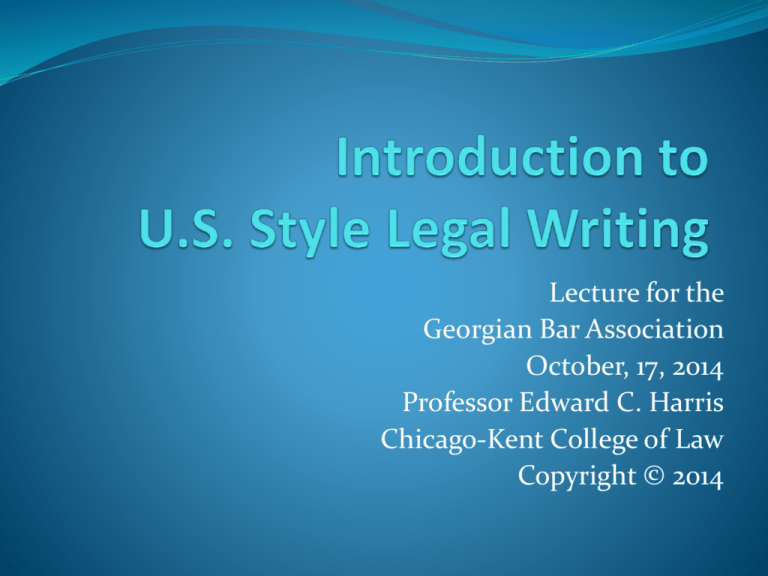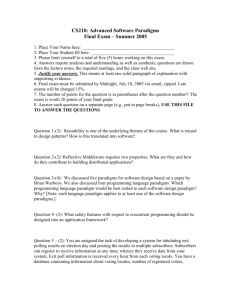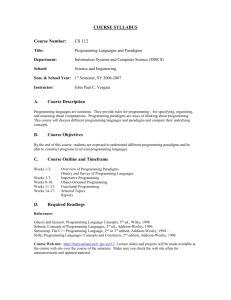power-point-slides-for-Georgian-Bar-Association-Lecture-Oct
advertisement

Lecture for the Georgian Bar Association October, 17, 2014 Professor Edward C. Harris Chicago-Kent College of Law Copyright © 2014 Sources of Law in the U.S. Primary vs. Secondary Mandatory vs. Persuasive Weight of a source is dependent on position of law making body in the hierarchy of authority. Sources of Law in the U.S. Legal Systems in the U.S. 50 State Systems plus Washington, D.C. 1 Federal System Military Legal System (not important for our purposes) Sources of Law in the U.S. Each system contains the obvious branches of government: Legislature (creates constitutional and statutory law) Executive (executes the law – but executive orders) Judicial (interprets law, but may make case law) Sources of Law in the U.S. Primary – the law! Constitutions Federal and state Statutes Federal and state Administrative Regulations Municipal Ordinances Case Law Priority in the order above! Sources of Law in the U.S. Constitutions Highest source General in character Describes the relationship and powers of each of the branches of government, but also includes important human/civil rights Sources of Law in the U.S. Statutes (Fed and State) Laws on specific subjects Process – two houses of congress/state legislature, plus approval of the President/Governor May be still too general on the subject for people and businesses to know what the law requires; May need the further source of administrative regulations for specifics Sources of Law in the U.S. Administrative Regulations (Fed and State) Municipal Ordinances All of the above are ENACTED sources of law Sources of Law in the U.S. Case law Rule of common law Statutory interpretation (or of an Administrative Regulation). How does it apply and how does it bind other courts??? The rule vs. the reasoning Reasoning by analogy – analogous vs. distinguishable Sources of Law in the U.S. Secondary sources… Not the law; commentary about the law Lots of different secondary sources Used to: Aid understanding Find other primary sources Sources of Law in the U.S. Sample of secondary sources: Legal encyclopedias Treatises / hornbooks Restatements (common law areas) Uniform laws and commentary Law review and journal articles Legal dictionaries Digests (not really a secondary source – a finding tool) Analytical Paradigms IRAC Typical for law school exams, but some lawyers use this in various forms of analysis Issue, Rule, Application, Conclusion CRuPAC Analytical Paradigms The paradigm that you use (whether IRAC or CRuPAC or something else) will change slightly and the language you use will change based on whether you are writing predictively or persuasively Predictive “Likely” Need to hedge to avoid having your words being interpreted as absolute Analytical Paradigms CRuPAC Conclusion: Start with this, and you may need to wait until you know the answer to write this portion. Your reader wants to know the result at the beginning. Analytical Paradigms CRuPAC Rule Here you want to state the relevant portions of the rule or rules that govern your facts. You may need more than one rule Move logically through this section by stating general rules first, then more specific rules, and exceptions to the rules Analytical Paradigms Proof of the rule: Your reader needs to know that the rule really is the rule in your jurisdiction. How? Citation to the applicable authority (simple) Explanation of the rule (more complex) Could be discussion of legislative record, case law, how the law has been applied to similar situations, etc. By the time your reader has read this information, he or she feels confident that the law is in fact the correct law, her or she understands it and how it applies Analytical Paradigms Application of the rule to the relevant facts. In your application of rule to facts, you need to make it obvious to your reader that the application of the rule leads to the conclusion that you mentioned at the beginning (and again at the end). Don’t leave out facts that could have an impact on the conclusion. Don’t leave out aspects of the rule that might be relevant to your prediction. Here is where you might also hint at information that you do not have and need to know. Analytical Paradigms Also in the application of rule to facts, you might want to also compare how the rule has been applied in the past to similar situations by the court (or relevant decisional body). This helps your reader see that your application of rule to facts is consistent with how the decisional body has previously applied the rule. This type of comparison is typically reserved for lengthier legal analysis, e.g., a full-length office memo. Analytical Paradigms Conclusion: Restate your conclusion and perhaps add something that indicates what you think the result means… such as, “the employer should consider a settlement negotiation with the former employee rather than take a risk of losing at trial…” Language and Organization The overall piece Section to section… (1) Intro/issue/background; (2) analysis (1, 2,3, or 4 parts); (3) do each of your main parts to the analysis need to be further divided into subparts? (4) conclusion Subsection to subsection – logical path Use headings and subheadings to guide the reader Paragraph to paragraph – logical path - one main idea leading to the next main idea Sentence to sentence – same Analytical Paradigms Use of transitional words and phrases to show the logical flow of ideas: In addition,… Further,… On the other hand, …. However,… Although,…. there is nevertheless…. These words mean something very specific and demonstrate the logical relationship between the idea that comes before and the one that follows. They give clear signals to your reader. Analytical Paradigms A few other language basics: Articles – definite and indefinite Verb form and agreement Active voice vs. passive voice Transactional Drafting (Contracts) “Legalese” vs Plain English Organizing a contract (see course materials Section 4) Definitional terms or terms of art: how to define, how to use, and consistency, consistency, consistency! Transactional Drafting (Contracts) Parts of a typical contract – what they are and what they do: Title Introductory Paragraph Recitals Transitional clause Transactional provisions (substantive) Definitions Key elements of the transaction – this is the “what” and “how” of the transaction Transactional Drafting (Contracts) Transactional provisions (continued) Representations and Warranties Covenants Term, termination, and breach Anything else??? Notices Transactional Drafting (Contracts) Miscellaneous provisions: Severability Choice of law Choice of forum Attorneys fees Modification Assignment No waiver Merger clause – Parole Evidence Rule Transactional Drafting (Contracts) Miscellaneous (continued) Liquidated damages ??? Maybe in the main body of the contract under “breach” Force majeure Other??? Signature Block Name, title, and date Notary? Annexes




